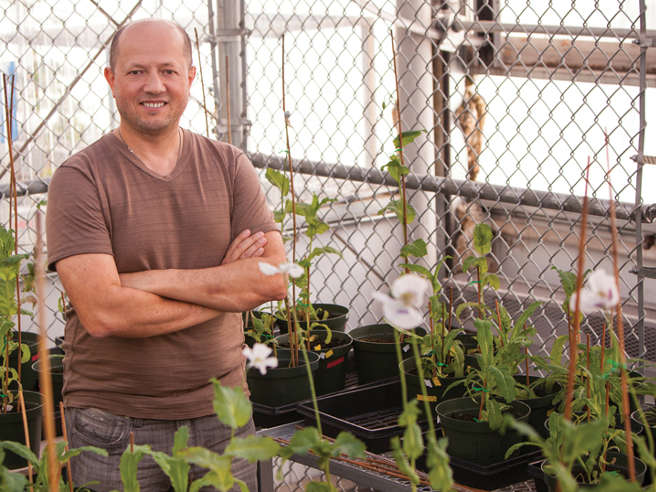Classical genetics has been with us for a long time, ever since Gregor Mendel put forward his laws on the basic mechanisms of heredity in the 19th century.
Classical genetics has led to wondrous developments in agriculture, including GM and gene editing technologies. And now, another area of study is on the cusp of changing our ideas about plant function even more.
Epigenetics, although it has existed as a concept for nearly eight decades, is becoming a new buzzword that’s causing lots of chatter in plant breeding and seed circles, and for good reason.
“Epigenetic technologies are on the cusp of being industry-ready. Unlike techniques such as CRISPR, it’s not quite there yet — but very close,” says Michiel van Lookeren Campagne, head of seeds research at Syngenta.
A field like epigenetics holds great promise for a company like Syngenta, he says, which invests a lot of time and money in dealing with the regulatory hurdles that invariably come with breeding plants that have had their genetic codes altered in some way.
Flipping Switches
Epigenetics comes from the Greek root word epi, meaning “on” or “on top of.”
“Epigenetics essentially sits on top of the layer of classical genetics, which has been the basis of all breeding programs,” says van Lookeren Campagne.
Epigenetics is the study of heritable changes in gene function that do not involve changes in the DNA sequence. Epigenetic changes in plants do not occur as a result of any changes to the plant’s DNA, but as a result of other factors like changes to chromosomes that affect gene activity and expression.
Basically, van Lookeren Campagne explains, epigenetic changes occur when various “switches” in DNA are flipped on and off, triggering different reactions within the plant. He notes that epigenetics as a field really took off in the 1990s when Dutch and American molecular biologists studying flower color of petunias obtained a number of unexpected results that were difficult to explain.
They were trying to increase the color intensity of the petals in petunias by introducing a gene inducing the formation of red pigment in the flowers. But instead of intensifying the color, this treatment led to a complete loss of color and the petals turned white. The mechanism causing these effects remained elusive until Andrew Z. Fire and Craig C. Mello discovered the cause, earning them the Nobel Prize in Physiology for Medicine for 2006.
Fire and Mello deduced that double-stranded RNA can silence genes, that this RNA interference is specific for the gene whose code matches that of the injected RNA molecule, and that RNA interference can spread between cells and even be inherited.
In other words, genes can be turned on and off like light switches, producing different reactions within a plant without altering the plant’s genetic code in any way. In the mean time, a number of other mechanisms (such as DNA methylation) with similar effects have been discovered as well, and the whole epigenetics field has become a hot topic for study in university labs.
New Frontier
Those epigenetic changes are ushering in a new frontier for the seed industry as a result. In March, Epicrop Technologies Inc., a company co-founded by University of Nebraska-Lincoln professor Sally Mackenzie, announced it has closed a $3.2 million Series A-2 financing round. The funding will be used to further develop its epigenetic technology that creates large increases in yield and stress tolerance in crops.
“We’re very excited to have previous and new investors on board who appreciate the game changing potential of this technology,” said Michael Fromm, chief executive of Epicrop Technologies.
“Increasing yield and stress tolerance are key goals of most seed companies. Epicrop’s method has the potential to provide these traits by adding epigenetic information directly to the seeds of commercial varieties without adding any genetic material. The unique features of this method readily fit into traditional commercial breeding and seed production methods to facilitate company adoption of this system.”
In the company’s field and greenhouse trials, epigenetically improved plants — soybeans, tomatoes, sorghum and Arabidopsis — show increased yields and stress tolerance.
New research led by Z. Jeffrey Chen at the University of Texas at Austin may result in a new way of breeding heartier, more productive cotton through epigenetic modification.
The researchers identified more than 500 genes that are epigenetically modified between wild cotton varieties and domesticated cotton, some of which are known to relate to agronomic and domestication traits. This information could aid selection for the kinds of traits that breeders want to alter, like fiber yield or resistance to drought, heat or pests. For example, varieties of wild cotton might harbor genes that help them respond better to drought, but have been epigenetically silenced in domesticated cotton.
Chen and his colleagues at Texas A&M University and Nanjing Agricultural University in China report they produced a “methylome” — a list of genes and genetic elements that have been switched on or off through a natural process called DNA methylation. A methylome provides important clues for biotechnology firms that want to adapt crops through epigenetic modification.
“Knowing how the methylome changed during evolution and domestication will help bring this technology one step closer to reality,” Chen says.
Poppies on the Prairies
In Alberta, Canada, University of Lethbridge Department of Biological Sciences researcher Igor Kovalchuk has gained the reputation as a world leader in epigenetics.
His goal: to produce hardier crops that are increasingly resistant to stress and even able to detect pollution. This capability, in turn, will help to improve the efficiency, profitability and overall success of farms.
Thanks to Kovalchuk, in fact, the Canadian Prairies could one day be dotted with fields of medicinal poppies. He is currently working with a Canadian biotech company that plans to develop a market for the high thebaine poppy industry in Canada. A significant cash crop opportunity, high thebaine poppies are used to create valuable medicines, but unlike their traditional counterparts, cannot easily be converted into heroin.
Kovalchuk is also a driving force behind the establishment of the Alberta Epigenetics Network, the first epigenetic network in Canada.
“Plants have an amazing capacity to respond immediately to stress and to propagate this response so future generations can be better prepared,” he says.
One of the ways plants do this, of course, is via epigenetic changes.
For van Lookeren Campagne, the doors yet to be unlocked by epigenetics are many, and he’s excited as new research initiatives are undertaken to bring epigenetic technologies to market.
“We now understand the machinery that epigenetic changes are related to, and we’re able to tune that machinery. Now we have to find the applications we can deploy this toward. It holds a lot of potential and promise.”
—with files from Marc Airhart (University of Texas at Austin), Justin Raikes (Epicrop Technologies), Dana Yates (University of Lethbridge)











